

Reflections of the Viking Age - Artisans and SkaldsMuch of our understanding of the Viking Age is largely based on the wealth of objects that have been preserved down the centuries. In some cases these are the result of the elaborate preparations for the afterlife made for pagan royalty within their ship burials. It may be the contents of a 'hoard' - personal wealth hidden by an owner who never returned for it. Perhaps our clearest view of life at the turn of the first millennium is given by the excavation of town sites, mainly through everyday garbage! Getting a full and accurate view of a past age through its remains is never easy. What we find is as much a result of luck as it is science, preservation can be more the result of happy accident than of original intent. We know that behind the Viking marauder stood a wide assortment of master artisans. Obviously ship wrights and sword smiths, but also jewelers, weavers, carvers and leather workers, to name just those those skills best represented in the artefacts. Norse artistic work is bold, graphic and distinctive. Monstrous beasts are contorted to fill the available spaces, limbs intertwined with each other. Bodies are filled with lines dots or spiral joints. Flowing lines curve into spontaneous interlaced patterns with more energy than the rigid mathematical blocks used in the more familar Celtic art of the same period. Human figures are cartoon like, often with hidden details, but always in profile or seen straight on. Much of the embellishment consists of flat low relief laid over the regular surface of an object. Paint was often used on carved stone or wood, but mostly in wide flat areas of colour to highlight the carving. The skills of the blacksmith formed the weapons that enabled the Vikings to cut their bloody trail throughout Europe. The sword was the perfect weapon for the warrior, forged with long straight edges and simple straight cross guard. The work of the very best smiths, a sword was also expensive, and a tool for only one purpose. For many men, a more practical axe or spear was the weapon at hand, a tool that would serve primarily for cutting firewood or hunting game. Without the smith, there would be no iron at all, for tools and cooking equipment or ship rivets. Throughout the north, acidic bogs leached iron from the granite rock to leave behind deposits of rich 'bog iron'. This ore was smelted in specially constructed fires to reduce the nodules into a slag encrusted 'bloom', in turn hammered to purify it into 'wrought' iron. It would be this very process which would leave its remnants on the stream bank at L'Anse aux Meadows, Newfoundland. 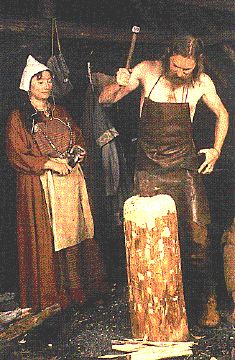
Short, thick bars from the smelter were a common trade item, exchanged for finished goods or silver. Once in the hands of the blacksmith, the bars would first be shaped with charcoal forges and small, block like anvils into long rods. From there the rods could be formed into all the basic tools on which most other work depended. Small belt knives were were worn by both men and women. Shears, needles and the teeth for wool combs were needed by the women for textile work. For the kitchen, bars would be flattened to iron sheet to make up segmented cauldrons. These required chain like hangers to support them over the hearth. Iron was formed into spits, large two tine forks, spiral and flat dish pans. Iron was considered a valuable enough material to even be turned into jewelry. There are many samples of 'C' shaped penannular brooches for cloaks, as well as bracelets, neck rings and buckles all of forged iron. The work of the jeweler was closely linked to that of the blacksmith, so much so that most collections of iron working tools also contain fine tools for silver or bronze work. The finest weapons often were decorated with inlaid silver, bronze and sometimes even gold patterns. Gold is not commonly found in Scandinavia, it was silver that was the wealth of the Viking Age. Bracelets, brooches and neck rings were all created in distinctive Norse styles, using specific design elements that change over the period. Often larger and more complex pieces will use a combination of techniques, with casting, granulation, engraving, punching and wire work. Colour was added by combining solid metal plaques with rough polished semi precious stones or brilliant glass beads, all often imported from distant lands. 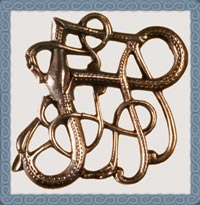
Second to silver was cast bronze, a material much used for things like brooches. A standard woman's fashion throughout the Viking Age was the wearing of a rectangular apron over the gown, secured by a pair of oval shaped 'turtle' brooches on the upper chest. (This is the truth behind the opera fantasy of women in metal brassieres!). Most commonly, the original brooches were cast in single use clay molds, fragments of these molds are a common find at town sites. The rough castings could be further refined by chiseling extra details, or applying glass beads on pins. Even simpler objects were cast in reusable slate or soapstone molds. For customers with less cash, these stone molds would be used to cast pendants of lead based alloys. For the very poorest, amulets and decorative pendants might be carved out of antler, bone or wood. This use of personal ornaments by people of both sexes, throughout the social and economic classes, shows that all of the Norse were fond of jewelry. Although iron is strength of the Viking Age, wood is the body - the most common material for objects of all kinds. Lacking long saws, timber was split from straight clear grained logs using axes and wedges. First the log would be split into quarters (hence the name - 'quarter split') and then each quarter into narrow pie shapes. This results in planks with great strength. Under force they tend to flex rather than shatter, obviously the ideal characteristic for ship timbers. Larger framing timbers for both ships and buildings would be carefully selected for the perfect natural shape and strength, with final shaping done with axe and adze. Not only used for ship hulls, thin planks would form sleeping benches and panel the walls of the long house. Smaller lengths would be used to make rectangular sea chests both for storage and rowing benches. The end boards would extend to form a short leg to keep the contents dry on board ship, creating a distinctive shape. The basic tools of the woodworker have changed little from the Viking Age : various chisels, draw knives, spoon drill bits and carving knives, all look much the same. 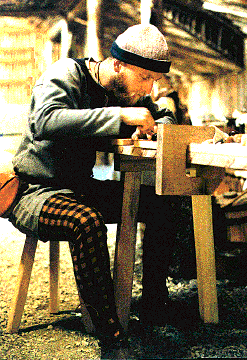
The combination of individual knives and long winters spent indoors tends to lead people to carving. The Norse had a real mania for carving, primarily in wood, but also in antler. Although few complete examples of wooden objects have survived the centuries, what has been found shows us a rich tradition of master carvers. The spectacular ship burials of Oseberg and Gokstad, sealed beneath a layer of blue clay, reveal complex surface embellishment on the sledges and wagons, even the ships themselves. Wooden beams and panels were also a working surface for carving, as suggested by such remaining buildings as the stave church at Urnes, Norway. As well as such masterworks, the surviving fragments of everyday objects show that even the average farmer would have been carving decoration on almost anything made of wood. 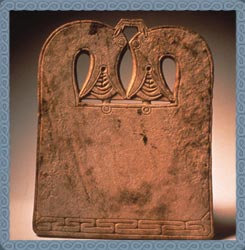
Storage for foodstuffs was commonly by means of buckets, pails and barrels. Wooden barrels, using saplings, rope or even metal bands to secure them, were the only water tight bulk storage available. If for no better reason to keep the mice out of the grain and to have someplace to make the beer, the services of the cooper were obviously of serious importance. Less complex work was to be found in everyday items. Cups and bowls were produced on simple foot powered lathes. A plank of wood and a few hours with a knife could make someone a rectangular trencher, often with a simple game board cut into the back surface. An interesting burl might be hollowed out into a drinking cup or a ladle. Another popular image of the Viking Age is the curved horn, filled with beer or honey based mead. Any dead cow gave up two horns, which were cleaned, and scraped and polished. A substance related to your finger nails, small pieces of horn could be shaped, boiled until soft, then clamped in molds until hard to produce spoons, cups, and combs. 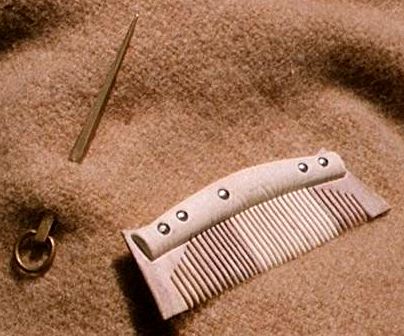
Antler and bone were also useful raw materials. Combs were constructed of a flat plate of bone or antler with each tooth carefully cut with a small saw. This would be strengthened with two bars of antler, all held together with metal rivets. To protect the fragile teeth, a case would be made of antler in a similar fashion. The large number of such combs found shows that the Norse were not the 'hairy barbarians' of imagination, but were well groomed and concerned with their personal appearance. Both bone and antler were also used to form needles and pins. Carefully scraped to size, bone can actually get quite sharp, and needles ranged in size from tiny ones for sewing to larger ones for knitting or net work. Bone pins were used to hold fabric for sewing, securing garments, pure ornament, or in a woman's hair. These words are from the 'Havamal' or 'Words of the High One', a collection of folk wisdom in poetic form attributed to the god Odin, but certainly composed during the Viking Age. The Norse lived in an oral, or spoken culture, rather than one based on reading and the written word. Those long dark nights gathered around the fire while the winter winds roared out side was the perfect time for old stories to be told and remembered. People who rely in spoken history develop amazing memories, even complex tales could be repeated accurately on a single hearing. A special class of story teller; part historian, part poet, part entertainer, was the 'Skald'. The stories they composed and recounted of family histories, heroic events, and legends of the gods, are called the Sagas. Individual sagas were passed down with only few alterations for hundreds of years before they ever were recorded on parchment. The earliest recorded versions of many of these tales date to 1200 - 1300. 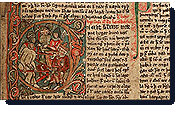
Through Scandinavia before and during the Viking Age, a 'runic' system of writing was in everyday use. The letters were composed of straight vertical or diagonal strokes, originally designed to be easily carved into wood. There were less letters than used in our Latin alphabet, and like it, the system was called the 'futhark' after the first several letters. Most commonly, the runes were used for short statements such as memorial descriptions on large carved stones. Another use was to mark ownership or an artists name. "Thorfast made a good comb" is found carved into an bone comb case found in Lincoln, England - obviously Thorfast was a man proud of his craftsmanship. The runes are said to have been created by the god Oðin to allow him to foretell the future. There is no archaeological evidence however, to support the modern idea of 'casting the runes' with marked stones or wood tiles. Although there are a few obscure references in the Sagas to some type of divination, not one single artefact has ever been found that proves this specific method was used by the Norse themselves. The Sagas remain the single most important written record of how the Norse themselves viewed the events of the Viking Age. Two of these from Iceland, are particularly important to our story of Full Circle. These are 'The Saga of Eric the Red' and 'The Greenlander's Saga'. Both detail the voyages of exploration and settlement attempts in a new rich land to the west of the Greenland colony in a place called Vinland. It would be the geographic clues within these sagas that would lead Helge Ingstad to explore the rugged coast of Newfoundland for the site of the houses built by Leif Eriksson one thousand years before. He was to find them in the early 1960's in a remote place on the most northern tip of Newfoundland, at L'Anse aux Meadows. |